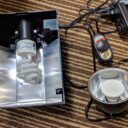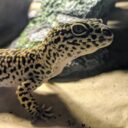This is the second article in this series. The first article is here.
Vivarium Construction
Enclosure and Hardscape
It is important when creating a naturalistic enclosure to provide adequate space. Your plants grow fuller when given more room, and a larger substrate area absorbs waste faster. I selected an Exo Terra Small Tall enclosure (18”x18”x24”) for my gargoyle gecko, which is the minimum I would consider using for an adult home.
Many people create three-dimensional foam backgrounds, but I’ve always preferred to leave as much tank space open as possible—plus cork is a lot less messy! A flat cork tile acted as the base, and each feature was attached using screws and aquarium sealant disguised with coconut fiber.
The selected background items checked off my list of gargoyle gecko requirements: The cork tube is a dark hide, and the wall planters house a higher level of vegetation to increase shade. The mushroom ledge is a basking area. The cork tube on the floor acts as a humid hide. All the elements, including the branch, provide climbing access to a large portion of the enclosure.
Substrate and Plants
I opted to use a pre-made vivarium substrate heaped over a drainage layer and screen separator. It’s very important to use something other than soil and coconut fiber to add structure and aeration in humid enclosures. The substrate was enhanced with the addition of half-strength organic fertilizer and a bioactivity booster containing beneficial fungi.
Finding safe plant species that will withstand a large gecko can be challenging. You’re looking for sturdy stems and leaves. Sansevieria and Pothos are both good bets and extremely difficult to kill. Keep watering and humidity requirements in mind when looking into plants, as well as their mature size. I usually roll the dice on plant packs from vivarium suppliers, which are cheaper than individual purchases. Packs are often designed around certain species, and this guidance can be helpful.
Your enclosure is going to have a range of conditions for planting. Ground level is the most humid, while planters positioned farther up on walls will be drier. You can mount plants epiphytically on walls and ledges using sphagnum moss, but keep in mind they will be subjected to the ambient air humidity.
I checked the light and humidity requirements of each plant, as well as their expected size and growth pattern, then tested out layouts until I had a place for each.
The mahogany fern, which will grow the tallest, was given a corner of its own up front. Humidity lovers, like the moss, Pilea, Begonia, and lemon button fern, took up the rest of the floor space. I relegated the Pothos to the back corner to keep its growth contained. Hoya and Philodendron, both which need to dry slightly between waterings and prefer to grow downward, were given spots in the wall planters. Finally, plants that could be mounted as epiphytes, Dischidia and Cryptanthus, were placed high on the background, anchored by sphagnum moss.
Once the planting was done, it was time to add the custodians. I seeded this enclosure with springtails and dwarf isopods, later adding powdery orange isopods. The final touch was a layer of live oak leaf litter. The entire enclosure was given a very thorough watering and misting on planting day.
Heat, Light, and Humidity
To meet the needs of the plant community, the front Exo Terra canopy top was fitted with two, 13-watt Jungle Dawn LED bulbs. The basking area was composed of a smaller Exo Terra top with a 13-watt UVB100 compact fluorescent bulb and a small dome with a 25-watt ceramic heat emitter (CHE). All lights were on a timer to provide a day-night cycle, but the CHE was always on, controlled by a rheostat.
Monitoring is extremely important when keeping reptiles, and a valuable tool to invest in is a temperature gun that reads surface temperatures. I used one to verify that the basking area was reaching an appropriate temperature while leaving the rest of the enclosure cool. A small area of 85-90 °F is just right. This spot is hotter during the day while the lights are on, but the heat does not extend far beyond the basking shelf.
Another useful tool is a UV index meter. Note that these can be expensive, so for the reptile hobbyist, following manufacturer recommendations for UVB bulb placement is adequate.
The UVB bulb provided a fairly high reading on the shelf directly underneath, 1.9-3.0, which is equivalent to partial sunlight. The UVB dropped off as the meter moved away from the shelf, providing a gradient. Gargoyle geckos in the wild have the choice of exposing themselves to sunlight, but as nocturnal geckos, they are apt to bask only partially or use light reflected through plants to receive a much lower level of UV.
Maintaining humidity can be accomplished by hand misting, but I have had better results using automated misting systems. Two mist nozzles were installed and set to mist for short intervals several times during the night.
Keep track of your humidity with a digital hygrometer and use your fingers to monitor the vivarium substrate. You want to maintain the right humidity cycle without saturating your substrate. You can always water the plants directly every few weeks as needed, but if you over-mist and your substrate is always sopping wet, you risk killing your plants and failing to maintain bioactivity.
Final Touches
After surveying the work, I chose to add an additional branch spanning the enclosure, providing access to open space where plants were not likely to grow. The branch was suspended using parachute cord and strong magnets; this technique makes it easy to relocate or replace items. A magnetic feeding ledge and small calcium dish were the last items my gecko would need.
After Care
Cycling Period
In the initial month after planting, any enclosure should be left uninhabited. Keep your plants watered more than usual; while they are developing new roots, they will be more susceptible to dehydration. If you can leave your enclosure even longer before adding your gecko, a few months will ensure your plants are well rooted and can’t be dislodged by a flying leap.
A week after planting, you should be able to tell whether your plants are adjusting well or need to be moved. By then, I found new growth on the Pothos, Pilea, and Dischidia, and none of the other plants were displaying extensive wilting, yellowing, or browning.
You may see mold bloom up within the first few weeks, but this is not a reason for alarm. This is typical of bioactive enclosures, and your custodians should manage it.
Use this cycling time to monitor temperature, humidity, and substrate moisture. It’s a great opportunity to tweak timers and adjust rheostats/thermostats.
Animal Introduction
After a month or two, your plants and custodians should be well enough established to introduce your gecko. Your animal may seem agitated at first, or even hide, but don’t be discouraged. It can take several weeks for it to settle in and accept a new territory as its own. Your gecko will explore at its own pace.
Continuing Maintenance
These enclosures, if properly designed, can run for many years. You will have to prune plants as they get too large and add leaf litter as it is eaten and decomposes. You may also need to add additional substrate as the initial substrate compacts and degrades. If you lose a plant or two, you can troubleshoot and replace with something better suited. With the right planning, you can avoid the dreaded enclosure meltdown that requires complete rework. The reward for all your work will be watching your gecko delight in its new territory, all the features you have provided serving to engage its natural instincts.
Find more on YouTube
This article has a YouTube video series that follows along with the construction of this vivarium. Check out these videos for construction techniques and tips.
Resources
- NEHerp’s DIY Gecko Background
http://www.neherpetoculture.com/custombackgrounds2 - Solarmeter 6.5R UV meter and Ferguson Zones
https://www.solarmeter.com/model65r.html



